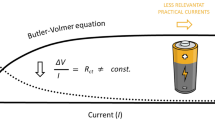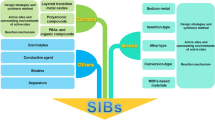Abstract
Context
In the present work, we investigated the adsorption mechanism of natural sodium (Na), potassium (K), and lithium (Li) atoms and their respective ion on two nanostructures: boron-nitride nanotubes (BNNTs) and beryllium-oxide nanotubes (BeONTs). The main goal of this research is to calculate the gain voltage for Na, K, and Li ionic batteries. Density function theory (DFT) calculations indicated that the adsorption energy between Na + is higher than that of the other cations, and this is particularly clear in the BeONT. Furthermore, gain voltage calculations showed that BNNTs generate a higher potential than BeONTs, with the most significant difference observed in BNNT/Na + . This research provides theoretical insights into the potential uses of these nanostructures as anodes in Na, K, and Li-ion batteries.
Method
Density function theory used to compute the ground state properties for BeONT and BNNT with and without selected atoms and their ions (Li, K, and Na). B3LYP used for exchange correlation between electrons and ions, and 6-31G* basis set used for all atoms and ions. Gauss Sum 2.2 software used for estimate the density of state (DOS) for all structure under investigation.















Similar content being viewed by others
Data availability
All data generated or analyzed during this study are included in this published article.
References
Scrosati B, Garche J (2010) Lithium batteries: status, prospects and future. J Power Sources 195(9):2419–2430
Cheekati S, Xing Y, Zhuang Y, Huang H (2011) Graphene platelets and their manganese composites for lithium-ion batteries. ECS Trans 33(39):23
Armand M, Tarascon J-M (2008) Building better batteries. Nature 451(7179):652–657
Zhang Q et al (2019) One-dimensional Fe7S8@ C nanorods as anode materials for high-rate and long-life lithium-ion batteries. App Surf Sci 473:799–806
Xiao Z, Yang Z, Li Z, Li P, Wang R (2019) Synchronous gains of areal and volumetric capacities in lithium–sulfur batteries promised by flower-like porous Ti3C2T x matrix. ACS nano 13(3):3404–3412
Kaloni TP, Cheng Y, Kahaly MU, Schwingenschlögl U (2012) Charge carrier density in Li-intercalated graphene. Chem Phys Lett 534:29–33
Kim H-J et al (2020) A comprehensive review of Li-ion battery materials and their recycling techniques. Electronics 9(7):1161
Li H, Yin H, Wang K, Cheng S, Jiang K, Sadoway DR (2016) Liquid metal electrodes for energy storage batteries. Adv Energy Mater 6(14):1600483
Chayambuka K, Mulder G, Danilov DL, Notten PH (2020) From Li-ion batteries toward Na-ion chemistries: challenges and opportunities. Adv Energy Mater 10(38):2001310
Luo J-M et al (2020) Hollow carbon nanospheres: syntheses and applications for post lithium-ion batteries. Mater Chem Front 4(8):2283–2306
Goodenough JB, Park K-S (2013) The Li-ion rechargeable battery: a perspective. J Am Chem Soc 135(4):1167–1176
Momeni MJ, Mousavi-Khoshdel M, Targholi E (2017) “First-principles investigation of adsorption and diffusion of Li on doped silicenes: prospective materials for lithium-ion batteries. Mater Chem Phys 192:125–130
Darwiche A, Dugas R, Fraisse B, Monconduit L (2016) “Reinstating lead for high-loaded efficient negative electrode for rechargeable sodium-ion battery. J Power Sources 304:1–8
Xiao L et al (2016) “Hard carbon nanoparticles as high-capacity, high-stability anodic materials for Na-ion batteries. Nano Energy 19:279–288
Liu Y et al (2016) “TiS2 nanoplates: a high-rate and stable electrode material for sodium ion batteries.” Nano Energy 20:168–175
Momeni MJ, Targholi E, Mousavi-Khoshdel M (2016) “Maleic anhydride as a promising anode material for Na-ion and Li-ion batteries with using a proper substrate: a first principles study.” Comput Mater Sci 124:166–172
Sharifi N, Ardjmand M, Ahangari MG, Ganji MD (2013) Si-decorated graphene: a superior media for lithium-ions storage. Structural Chemistry 24:1473–1483
Guo F et al (2019) Advanced lithium metal–carbon nanotube composite anode for high-performance lithium–oxygen batteries. Nano Lett 19(9):6377–6384
Zheng S et al (2017) Graphene-based materials for high-voltage and high-energy asymmetric supercapacitors. Energ Storage Mater 6:70–97
Wang L, Hu J, Yu Y, Huang K, Hu Y (2020) Lithium-air, lithium-sulfur, and sodium-ion, which secondary battery category is more environmentally friendly and promising based on footprint family indicators? J Clean Prod 276:124244
Kahaly MU, Waghmare UV (2007) Vibrational properties of single-wall carbon nanotubes: a first-principles study. J Nanosci Nanotechnol 7(6):1787–1792
UpadhyayKahaly M, Waghmare UV (2007) Size dependence of thermal properties of armchair carbon nanotubes: a first-principles study. Applied physics letters 91(2):023112
Behmagham F, Vessally E, Massoumi B, Hosseinian A, Edjlali L (2016) A computational study on the SO2 adsorption by the pristine, Al, and Si doped BN nanosheets. Superlattice Microst 100:350–357
Lee SW et al (2010) High-power lithium batteries from functionalized carbon-nanotube electrodes. Nat Nanotechnol 5(7):531–537
Hardikar RP, Das D, Han SS, Lee K-R, Singh AK (2014) Boron doped defective graphene as a potential anode material for Li-ion batteries. Phys Chem Chem Phys 16(31):16502–16508
Kostoglou N et al (2020) Boron nitride nanotubes versus carbon nanotubes: a thermal stability and oxidation behavior study. Nanomaterials 10(12):2435
Kahaly MU, Waghmare UV (2008) Contrast in the electronic and magnetic properties of doped carbon and boron nitride nanotubes: a first-principles study. J Phys Chem C 112(10):3464–3472
Golberg D et al (2010) Boron nitride nanotubes and nanosheets. ACS Nano 4(6):2979–2993
Maselugbo AO, Harrison HB, Alston JR (2022) Boron nitride nanotubes: a review of recent progress on purification methods and techniques. J Mater Res 37:4438–4458
Baima J, Erba A, Rérat M, Orlando R, Dovesi R (2013) Beryllium oxide nanotubes and their connection to the flat monolayer. J Phys Chem C 117(24):12864–12872
Roberto-Neto O, de Carvalho EFV (2020) A DFT and wave function theory study of hydrogen adsorption on small beryllium oxide clusters. Theoret Chem Accounts 139:1–10
Dehaghani MZ et al (2020) Fracture toughness and crack propagation behavior of nanoscale beryllium oxide graphene-like structures: a molecular dynamics simulation analysis. Eng Fract Mech 235:107194
Huang XL, Wang Y-X, Chou S-L, Dou SX, Wang ZM (2021) Materials engineering for adsorption and catalysis in room-temperature Na–S batteries. Energy Environ Sci 14(7):3757–3795
Er D, Li J, Naguib M, Gogotsi Y, Shenoy VB (2014) Ti3C2 MXene as a high capacity electrode material for metal (Li, Na, K, Ca) ion batteries. ACS Appl Mater Interfaces 6(14):11173–11179
Ding X, Huang Y, Li G, Tang Y, Li X, Huang Y (2017) Phosphorus nanoparticles combined with cubic boron nitride and graphene as stable sodium-ion battery anodes. Electrochimica Acta 235:150–157
Demiroglu I, Peeters FM, Gulseren O, Çakır D, Sevik C (2019) Alkali metal intercalation in MXene/graphene heterostructures: a new platform for ion battery applications. The journal of physical chemistry letters 10(4):727–734
Tyagi N, Jaiswal NK (2022) Enhancing the performance of BN nanosheets as promising anode material for Li-ion batteries with carbon-doping. Journal of Molecular Graphics and Modelling 115:108213
Al-Sanjari HA et al (2022) Exploring the role of Stone-Wales defect in boron nitride nano-sheet as a anode Mg-ion batteries. Inorg Chem Commun 146:110098
Al-Seady MA, Ahmed E, Abduljalil HM, Kahewish AA-R (2021) Studying the adsorption energy of CO gas molecule in different nano-systems using density function theory. Egypt J Chem 64(5):2607–2612
Zare K, Shadmani N (2013) Comparison of drug delivery systems: nanotube and p-Sulphonatocalix [4] arene, by density functional theory. J Nanostruct Chem 3:1–6
Al-Seady MA, Grmasha RA, Al-Aaraji NA-H, Abduljalil HM (2021) Investigation adsorption mechanism of methane gas in graphene and copper doped nano-ribbon using density function theory. Journal of Physics: Conference Series. IOP Publishing 1879(3):1–7
Mohammadzaheri M, Jamehbozorgi S, Ganji MD, Rezvani M, Javanshir Z (2023) Toward functionalization of ZnO nanotubes and monolayers with 5-aminolevulinic acid drugs as possible nanocarriers for drug delivery: a DFT based molecular dynamic simulation. Phys Chem Chem Phys 25(32):21492–21508
Pasdar H, ElmiFard N, Rezvani M (2023) Fabrication of MoS2/Bi2S3 heterostructure for photocatalytic degradation of metronidazole and cefalexin and antibacterial applications under NIR light: experimental and theoretical approach. Applied Physics A 129(5):380
Kulpa-Greszta M, Tomaszewska A, Dziedzic A, Rzeszutek I, Pązik R (2023) Heat generation on Fe3O4@ SiO2@ Au core-shell structures using the synergy of an alternating magnetic field and NIR laser light within Ist biological optical window. Mater Today Commun 35:105513
Al-Seady MA, Abdul Wahhab NA, Abbood HI, Abduljlil HM (2021) DFT study of chemical adsorption of NO2 gas on graphene nano material. Materials Science Forum. Trans Tech Publ 1039:391–397
Beheshtian J, Peyghan AA, Bagheri Z (2012) Detection of phosgene by Sc-doped BN nanotubes: a DFT study. Sensors Actuators B: Chem 171:846–852
Selmi T et al (2018) Physical meaning of the parameters used in fractal kinetic and generalised adsorption models of Brouers–Sotolongo. Adsorption 24:11–27
Ma L-C, Zhao H-S, Yan W-J (2013) Structural, electronic and magnetic properties of linear monoatomic chains adsorption on beryllium oxide nanotube: first-principle study. J Magn Magn Mater 330:174–180
Mashhadzadeh AH, Ahangari MG, Dadrasi A, Fathalian M (2019) Theoretical studies on the mechanical and electronic properties of 2D and 3D structures of beryllium-oxide graphene and graphene nanobud. Applied Surface Science 476:36–48
Bergmann CP, Machado FM (2015) Carbon nanomaterials as adsorbents for environmental and biological applications (pp 1–105). New York: Springer International Publishing
Hosseinian A, Khosroshahi ES, Nejati K, Edjlali E, Vessally E (2017) A DFT study on graphene, SiC, BN, and AlN nanosheets as anodes in Na-ion batteries. J Mol Model 23:1–7
Xiao B, Li Y-C, Yu X-F, Cheng J-B (2016) Penta-graphene: a promising anode material as the Li/Na-ion battery with both extremely high theoretical capacity and fast charge/discharge rate. ACS Appl Mater Interfaces 8(51):35342–35352
Meng YS, Arroyo-de Dompablo ME (2009) “First principles computational materials design for energy storage materials in lithium ion batterie. Energ Environ Sci 2(6):589–609
Nejati K, Hosseinian A, Edjlali L, Vessally E (2017) The effect of structural curvature on the cell voltage of BN nanotube based Na-ion batteries. J Mol Liq 229:167–171
Dolgopolova EA (2019) Metal-Organic Frameworks: Photophysics, Energy Transfer, and Electronic Structure. PhD Thesis. University of South Carolina
El Gaafary M et al (2021) Synthesis, cytotoxic activity, crystal structure, DFT studies and molecular docking of 3-amino-1-(2, 5-dichlorophenyl)-8-methoxy-1 H-benzo [f] chromene-2-carbonitrile. Crystals 11(2):184
Author information
Authors and Affiliations
Contributions
The first draft of the manuscript was written by Mohammed A. Al-Seady and Mousumi Upadhyay Kahaly; other authors commented on previous versions of the manuscript.
Corresponding author
Ethics declarations
Competing interests
The authors declare no competing interests.
Additional information
Publisher's Note
Springer Nature remains neutral with regard to jurisdictional claims in published maps and institutional affiliations.
Rights and permissions
Springer Nature or its licensor (e.g. a society or other partner) holds exclusive rights to this article under a publishing agreement with the author(s) or other rightsholder(s); author self-archiving of the accepted manuscript version of this article is solely governed by the terms of such publishing agreement and applicable law.
About this article
Cite this article
Al-Seady, M.A., Abed, H.H., Alghazaly, S.M. et al. Prospective utilization of boron nitride and beryllium oxide nanotubes for Na, Li, and K-ion batteries: a DFT-based analysis. J Mol Model 29, 348 (2023). https://doi.org/10.1007/s00894-023-05752-9
Received:
Accepted:
Published:
DOI: https://doi.org/10.1007/s00894-023-05752-9




